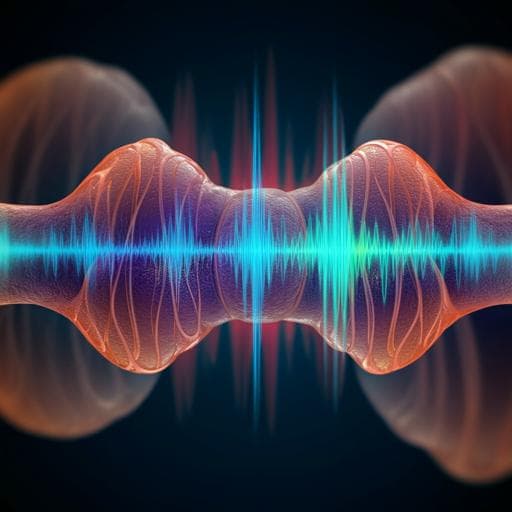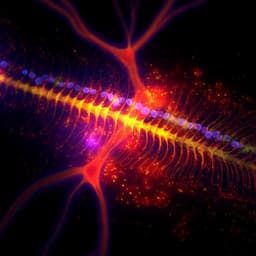
Engineering and Technology
A low-voltage-driven MEMS ultrasonic phased-array transducer for fast 3D volumetric imaging
Y. Zhang, T. Jin, et al.
Discover the potential of wearable ultrasound imaging technology! Developed by Yun Zhang and colleagues at the Institute of Microelectronics of the Chinese Academy of Sciences, this innovative low-voltage MEMS ultrasonic phased-array transducer enables fast 3D volumetric imaging, paving the way for continuous deep-tissue monitoring in wearable applications.
~3 min • Beginner • English
Introduction
Wearable ultrasound devices that enable noninvasive, continuous imaging of deep tissues could significantly contribute to the early detection and surveillance of various diseases. Moreover, fast 3D volumetric imaging can facilitate full-volume acquisition within a short period, allowing improved accuracy and reproducibility over 2D methods for automated surface extraction and quantification, real-time transesophageal imaging, and accurate navigation within the 3D volume. For example, the complex nature of the cardiovascular system can render thorough anatomic evaluation of malformations challenging. In such cases, the perspective given by fast volumetric imaging can provide a complete assessment of the extent and severity of valvular or other abnormalities during diagnosis. Additionally, continuous monitoring can aid in understanding such pathophysiological or other conditions across an extended timeline and thus enables timely and accurate medical interventions to achieve better outcomes. However, existing ultrasound methods for imaging deep tissue enable either continuous monitoring or fast volumetric acquisition, but not both.
Conventional piezoelectric array transducers, which are suitable for volumetric imaging, exhibit limited applications in continuous monitoring owing to device bulkiness and fabrication. Normally, conventional piezoelectric array transducers operate in the isotropic thickness extension mode, where the impedance mismatch between the transducer material and the acoustic medium at interfaces causes the reflection of acoustic waves, resulting in a significant loss of acoustic energy. Hence, an acoustic impedance matching layer akin to human tissues has been added. Recently, piezoelectric composites surrounded by epoxy/polymer filling material, despite enhanced electromechanical coupling coefficients, still require a drive voltage higher than 25 V to achieve a notable penetration depth or merely allow the acquisition of 1D signals at a low voltage. Moreover, mechanical dicing in fabrication restricts pitch dimensions and causes the aliasing phenomenon. As a result, the above coupling problems limit the array-filling ratio of high-performance components, precluding the development of wearable systems that require a high integration density at a low power consumption. Facilitated by microelectromechanical system (MEMS) technology, micromachined ultrasonic transducers (MUTs) have been developed with the advantages of miniaturized footprints and easy array fabrication compatible with drive-integrated circuits, including capacitive micromachined ultrasound transducers (cMUTs) and piezoelectric micromachined ultrasound transducers (pMUTs). cMUTs typically exhibit large bandwidths and high electromechanical coupling coefficients, providing significant advantages in medical imaging and high-frequency applications. However, these advantages are counterbalanced by several limitations. cMUTs require electrostatic actuation to maintain small gap heights, necessitating high DC bias voltages. Additionally, the transduction process of cMUTs is nonlinear, potentially resulting in a reduced acoustic power output. This decrease in acoustic power can lead to performance degradation, particularly with increasing imaging depth. Moreover, the application of high DC voltages poses safety concerns and exhibits significant challenges in circuit design. Compared to cMUTs, pMUTs do not require a high bias voltage due to their passivity and thus are more suitable for wearable applications. pMUTs operating in the flexural vibration mode offer a lower acoustic impedance, and thus, it is easier to achieve a high acoustic coupling efficiency for long-term wearable use.
Moreover, how to drive high-density pMUT arrays in an efficient way is receiving increasing attention. In an array layout, the interactions between pMUT cells across the electrical, mechanical, and acoustic domains are referred to as coupling effects, also denoted as crosstalk. When operated for medical imaging, acoustic coupling dominates due to the damping vibration and increasing radiation pressure. To quantitatively characterize coupling effects, equivalent circuit (EQC) models have been developed for pMUT array design. The mutual radiation impedance and self-radiation impedance of each device are projected into the acoustic domain, accounting for acoustic coupling in the transmit and receive modes for pMUT arrays. However, their applications in medical imaging are still at an early stage, facing the challenges of insufficient quantitative and experimental validation. Prior works established EQC models for single elements and arrays and analyzed output performance or optimized designs, but did not include simulations and validation toward medical imaging applications.
As the size of high-density pMUT arrays increases, driving each PMUT cell through an individual channel remains difficult due to the complexity of the integrated circuit system. Grouping pMUT cells into one element for each drive renders the array scalable, reduces the number of drive elements, and allows ultrasound-on-chip design with low-power CMOS. Several studies grouped cells into elements for high-density arrays; however, none developed a theoretical analytical model to assess array performance for group driving or addressed acoustic crosstalk between elements. To the authors’ knowledge, full volumetric imaging results with low-voltage pMUT arrays have not been reported. Reported piezoelectric transducers for tissue monitoring or imaging generally require excitation voltages exceeding 20 V.
In summary, the authors introduce a novel hierarchical analytical EQC model for 2D phased-array pMUT transducers to quantitatively analyze crosstalk between cells grouped in parallel into elements and between elements in an expanded 2D phased array, enabling low-voltage-driven 3D volumetric imaging. In this work, flexural-mode pMUT cells are grouped in parallel into one drive channel (an element) and arranged in an 8 × 8-element 2D array, allowing programmable phases of 5-V pulses at each channel for 3D transmit/receive beamforming. The approach is experimentally validated and demonstrated in wire and vascular phantom imaging.
Literature Review
The paper reviews limitations of conventional piezoelectric array transducers (bulkiness, impedance mismatch, need for matching layers) and notes that piezoelectric composites still require >25 V for notable penetration or provide only 1D signals at low voltage. It contrasts cMUTs and pMUTs: cMUTs have large bandwidth and high electromechanical coupling but require high DC bias, exhibit nonlinear transduction, may have reduced acoustic power at depth, and pose safety and circuit challenges; pMUTs, being passive and operating in flexural mode, have lower acoustic impedance and better coupling for wearable use without high bias. Prior efforts on EQC modeling captured self- and mutual radiation impedance but lacked comprehensive simulation and experimental validation for medical imaging contexts. Works on grouping cells into elements (for photoacoustic endoscopy, intracardiac imaging, particle manipulation) reduced channel counts but did not provide analytical models for grouped-drive performance or quantify element-to-element acoustic crosstalk. The literature indicates a gap in demonstrating full volumetric imaging using low-voltage pMUT arrays, with prior tissue-imaging transducers typically driven at >20 V.
Methodology
Design and array architecture:
- Flexural-mode bilayer diaphragm pMUT cells (SOI-based) operating in d31 mode. A PZT layer is sandwiched between top/bottom electrodes atop passive Si in a cavity. The top electrode covers 67% of the cavity to maximize vibration energy.
- Cells are grouped electrically in parallel to form an element; each element comprises a 4 × 4 cell subarray. The full 2D phased array comprises 8 × 8 elements, each driven by a single channel with programmable phase for transmit/receive beamforming at 5 V.
Equivalent circuit (EQC) modeling (cell–element–array hierarchy):
- Electrical-to-mechanical transduction modeled with an electromechanical transformer ratio η converting drive voltage/current to membrane volumetric velocity U. Each cell characterized by blocked capacitance C0, mechanical impedance Zm, and acoustic radiation impedance Za.
- Self-radiation impedance for a circular diaphragm: Za_self = ρc[(J1(2kr_eff)/(2kr_eff)) + j H1(2kr_eff)/(2kr_eff)], where k is wavenumber, A is effective diaphragm area, r_eff is effective radius, J1 is first-order Bessel, H1 is first-order Struve.
- Mutual radiation impedance between cells accounts for acoustic crosstalk; a functional form Zg depending on r_eff, intercell center distance d, and k is used: Zg = (9 ρ c A(kr_eff) / (5 π^2 r_eff^2)) · (sin(kd)/(kd)) + j (cos(kd)/(kd)), with A(·) obtained via 10th-order polynomial curve fitting.
- For array modeling, an acoustic impedance network matrix [Za] of size [Ntot × Mtot Ntot × Mtot] aggregates self and mutual impedances across all cells in all elements. The total acoustic impedance seen by cell i is Za_i = Za_self + Σ_{j ≠ i} Zij.
- Transmission mode solution via KVL on the EQC provides each cell’s volumetric velocity and radiated pressure considering coupling within and between elements.
Fabrication (multilayer MEMS process on SOI):
- Steps: (I) Substrate preparation, (II) pattern top Pt electrode, (III) wet etch PZT, (IV) deposit SiNx (PECVD), (V) RIE etch SiNx, (VI) deposit Au/Ti (lift-off), (VII) DRIE etch Si to form cavities/diaphragms. Stack materials include Si, SiO2, Pt, PZT, SiN, Au.
- Surface/electrode quality characterized by SEM (top view and cross-section of PZT thin film) and surface roughness; example Sa ≈ 1.42 nm.
Experimental characterization setups (water tank):
- Transmission: drive PMUT, measure acoustic output with a calibrated hydrophone; instrumentation includes signal generator and oscilloscope.
- Receiving: insonify PMUT with transmitter, read received signals through PCB and oscilloscope; load Re as appropriate.
- Pulse-echo: same PMUT used for Tx/Rx against a reflector target; evaluate echo response.
Imaging demonstrations:
- Wire phantom and 3D vascular phantom experiments to evaluate volumetric coverage and frame rate. Phased-array beamforming with 5 V actuation at each element enables acquisition of 3D volumes (e.g., 40 mm × 40 mm × 70 mm) at up to 11 kHz frame rate.
Key Findings
- Low-voltage operation: The 2D pMUT phased-array operates with 5-V actuation per channel while enabling transmit/receive beamforming.
- High-speed volumetric imaging: Demonstrated 3D volumetric imaging at a frame rate of 11 kHz.
- Large volumetric coverage: Achieved imaging over 40 mm × 40 mm × 70 mm in wire and vascular phantom experiments.
- Scalable architecture: Grouping multiple pMUT cells (4 × 4 per element) into single drive channels reduces channel count and supports an 8 × 8-element phased array.
- Modeling and validation: A hierarchical EQC model (cell–element–array) quantitatively characterizes dominant acoustic coupling (self and mutual radiation impedances) within and between elements; experiments validate the model’s electrical, mechanical, and acoustic predictions (as described).
Discussion
The study addresses the key challenge of achieving fast, full-volume 3D imaging in a wearable, low-power form factor by leveraging pMUT arrays that do not require high DC bias. By grouping cells into elements and rigorously modeling acoustic crosstalk through a hierarchical EQC framework, the authors reconcile scalability with performance: inter-cell and inter-element coupling is quantified and incorporated into design and beamforming, enabling efficient 5-V operation. The demonstrated 11 kHz frame-rate volumetric imaging over a 40 × 40 × 70 mm volume shows that low-voltage pMUT arrays can capture rapid 3D dynamics suitable for deep tissue monitoring (e.g., cardiovascular structures) without sacrificing coverage. This combination of low drive voltage, array scalability, and validated coupling-aware modeling enhances the feasibility of long-term, wearable 3D ultrasound systems.
Conclusion
The paper introduces a low-voltage (5 V) MEMS ultrasonic phased-array transducer based on pMUT technology and a hierarchical cell–element–array EQC model that quantitatively accounts for acoustic coupling. The approach enables scalable array design (4 × 4 cells per element; 8 × 8 elements) and fast 3D volumetric imaging with large coverage (40 mm × 40 mm × 70 mm) at an 11 kHz frame rate, validated in wire and vascular phantom experiments. These results demonstrate a practical path toward wearable, chip-compatible, low-power 3D ultrasound imaging of deep tissues.
Limitations
Related Publications
Explore these studies to deepen your understanding of the subject.







